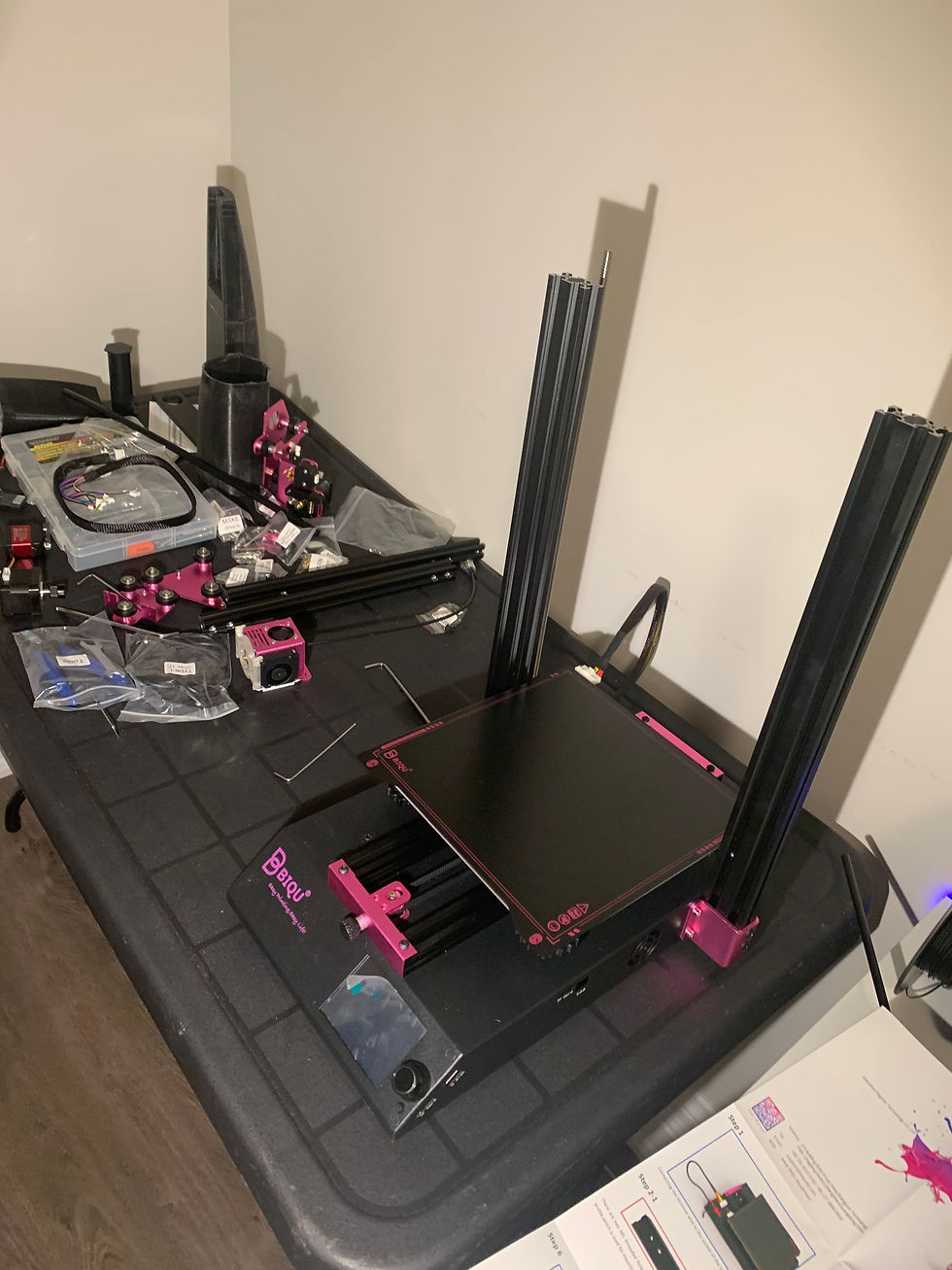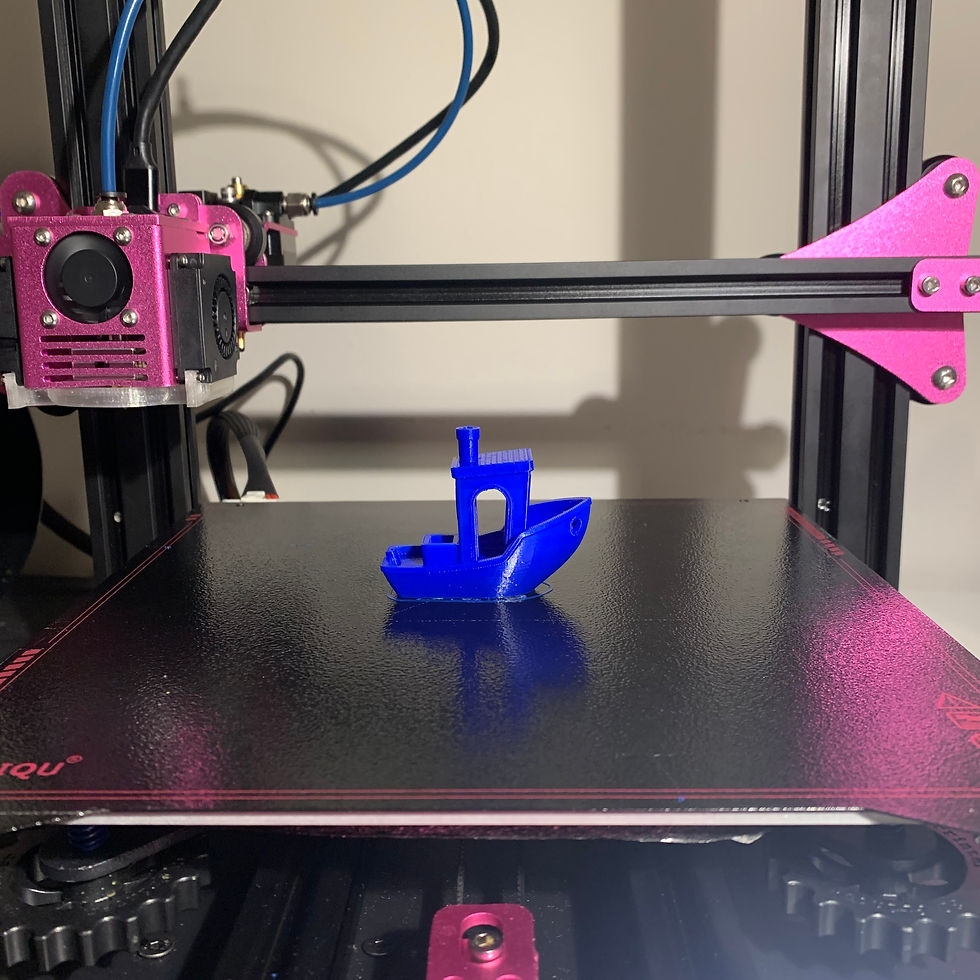The Best Ender 3 Clone Yet - BIQU B1 Review
- Peak 3D Printing
- Sep 10, 2020
- 4 min read
As the Ender 3 V2 makes its way into the hobby 3D printer market, BIQU has released a competitor to the ever popular Creality platform. It boasts quality upgrades in a clean, organized frame. The B1 is also the quietest printer we have ever used. Read our review to learn more about this exiting new machine.
Specs:
Build Size: 235 x 235 x 270 mm (20 mm taller than the Ender 3)
Heated Bed: Yes
Wifi: No
Electronics: SKR V1.4 32-bit board, TMC2225 Silent Stepper Drivers
Extruder Style: Bowden
Plastics Supported: PLA, PLA+, PETG, ABS, WOOD, PCL, TPE/TPU
Assembly Time: 30 Minutes
Slicer Profile: Cura (Included in SD Card)
Build Plate: BIQU Spring Steel Sheet Magnetic, Removable Bed
Who It's Meant For:
With it's pink aesthetics (Although BIQU has released a black version after negative feedback), the B1 looks like it's oriented towards home users and cosplay enthusiasts, which it's price point of about $350 CAD. Although meant for casual use, we can confirm that it's printing capabilities and reliability make the B1 suitable for more serious use. It may not be the best commercial printer, but it met our expectations for print-on-demand services and we continue to use it for those purposes today. It's oriented to the same people as the Ender 3.
Assembly:

The assembly was quite straightforward and the visual manual was clear and concise. Anyone that has assembled a 3D printer or is comfortable around machines will have no issues with assembly. BIQU has also released a video to aid with the build process. We did make one mistake and placed the Z axis bracket upside down, but it was our error and an easy correction. We stopped every step to take photos and videos of the process and it ended up taking us an hour to build, but we can't see why someone could put it together in 30 minutes or less. It is clear that a lot of effort went into the cable management of this printer. The extruder and fans connect to the printer base with a USB C cable. In case of a cable breakage, it's easy to find a USB C cable and skip the soldering.
After putting together the printer, we turned it on via the power switch on the back of the printer. The power supply has been integrated into the base which makes it a bit safer from models like the Prusa i3 MK3 and the Original Ender 3. The BIQU touchscreen and software are easy to navigate and have plenty of features. If you hold down on the click wheel for a few seconds, you are prompted with an option to switch to Marlin mode for those who prefer the popular firmware. On the included Micro SD card you can find a custom Cura profile for the B1. We started printing right away, but struggled for a few days with the Z axis not moving during prints which made prints squished down and the extruder to drag across the bed. We're still not 100% sure what was causing this issue but BIQU support instructed us to flash the firmware which fixed the problem.
Print Quality:

After a few test prints, we were blown away by the quality of the prints the B1 pumped out. The benchy came out nearly perfect, with an exception of some ghosting on the Y axis which we fixed easily by tightening the Y axis belt tension. After more fine tuning it was clear that the B1 was an extremely capable printer that can provide users with a high level of detail. Having two blower fans are a huge plus over the Ender 3 and make cooling on both X directions much better thus, we were able to print at steeper angles.
Removing prints has never been easier as well. The BIQU Spring Steel Sheet is a wonderful addition to the printer. Prints came off the bed so easily we could literally blow them off - and during printing we had no adhesion issues. And if you do have issues getting your print off the bed, you can easily remove the magnetic build plate and bend it without worrying about it snapping or loosing it's shape. It's truly game changing and we aren't kidding.
Built In Upgrades:
To remain competitive against the Ender 3 series, BIQU installed many Ender 3 upgrades built into the B1 as standard which is it's highest selling point. In it's simplest form, the B1 is just an upgraded Ender 3. Here are the upgrades it features:
- A BigTreeTech Touchscreen and 32 Bit Mainboard
- 2 Blower fans
- Power supply located in the base
- BLtouch port
- 2 SD Ports and 2 USB A ports, as well as a USB computer port
- USB C Cord
- Filament Sensor
- Whisper quiet printing
- BIQU SSS (Sping Steel Sheet) removable build plate
Pros:
- Super silent printing!
- Great build quality
- 32 Bit board paired with a colour touchscreen makes interacting with the printer easy
- Supports Marlin firmware
- Clean and organized frame
- Cheaper buying the B1 than upgrading an Ender 3
Cons:
- Pink frame is unattractive and the BIQU slogan should be removed (Although they released black)
- Tech support could be more accessible and professional
- Cura profile needs refinement
- Included SD card is slow and low quality
- Community is much smaller than the Ender community (so far...), so getting help from one of the Reddit or Facebook communities is harder
Verdict:
In conclusion, the B1 is a great choice for anyone who wants an Ender 3/Prusa i3 like printer at an affordable price which includes many useful upgrades. The B1 features great print quality, a silent experience in a refined and clean package. It would make a good first 3D printer, or an intermediate user who wants to add another easy to use printer to his/her print farm. It might not make the best educational 3D printer, but things may change in the future.

Comments